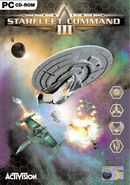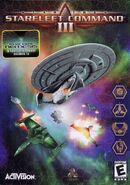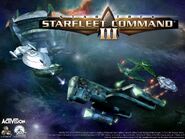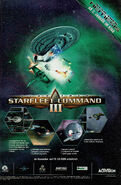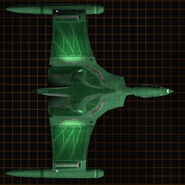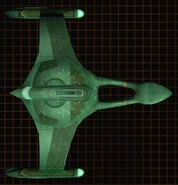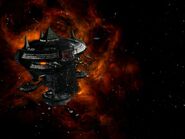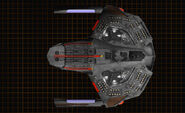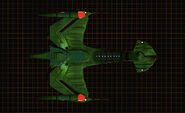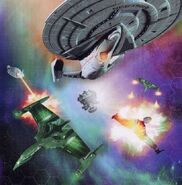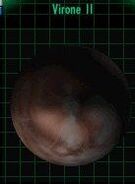Star Trek: Starfleet Command III is a video game published by Activision in 2002. Despite the 'III' in the name, it was in fact the fourth entry in the Starfleet Command franchise, and the only one to be set in the TNG era.
History[]
SFC 3 lets the player command his/her own starship, in much the same way Bridge Commander does, though in a much more limited fashion. It allows the player to customize their own ship, upgrading weapons, shields, computer systems, engines, Transporters, Tractors, and hull armor.
The game features 4 playable races: Federation, Klingon, Romulan, and Borg. The Federation, Romulan and Klingon races have their own storyline, in which the player follows orders from command, to accomplish it's own unique goals. All 4 races can be played in conquest mode, where the player can chose their own missions, and play at their own pace, with one goal in mind, conquer the entire galaxy.
After a 2003 lawsuit between Activision and Viacom, sales of the game were discontinued. Activision ended its online support for the game in August, 2007, by deactivating the online access servers which allowed gamers to login and access the dynaverse servers. A small community of independent gamers operating from dynaverse.net continues to maintain servers.
Summary[]
Starfleet Command III takes place shortly after the return of the USS Voyager to Federation space. The plot revolves around the construction of "Unity One", a joint Federation-Klingon starbase capable of detecting cloaked ships far into the Romulan Neutral Zone, and was intended to tie in to the then-upcoming feature film Star Trek Nemesis.
Klingon Empire - The player starts out as the younger son of the house of Mi'Qogh, and joins the elder brother Jureth for a mission before setting off on their own. The first few missions deal with the day-to-day dealings of the House and the Klingon Empire as a whole (such as anti-piracy patrols) before the player is asked to escort a convoy to Unity One, a station that is being built by the Federation and the Klingons in the Organian Treaty Zone. During these two missions, a race known as the Rakelli attack the convoy the player is escorting and then Unity One itself. It is also discovered that the Romulans are aware of the existence of Unity One, and they are none too happy about what they perceive to be a shift in the balance of power between the three governments. After this incident, the Klingons begin operations to bring the Rakelli in line. However, during these operations, Jureth's behavior changes drastically, and he begins ordering the player to commit acts that could be considered treasonous. Eventually, Jureth sends three vessels after the player, and the head of the House, General Mi'Qogh, must conclude that Jureth has become a threat to the Empire, with his ultimate goal being the destruction of Unity One. It then becomes a race to stop Jureth from carrying out his plans, and then the player must track down Jureth and bring him to justice.
Romulan Star Empire - The player starts out as a young Romulan commander who is being mentored by Admiral Arai, an agent of the Tal Shiar. The player starts out on a mission to locate and destroy some Klingon listening posts before embarking on missions revolving around day-to-day operations of the Empire. Arai then orders the player to penetrate the Organian Treaty Zone to survey the condition of Unity One after an 'incident' that has befallen the station. The player then participates in an initiation test at the behest of the Tal Shiar, and after the successful completion of said test, is briefed about the Tal Shiar's role in the events of the incident that befell Unity One and their ongoing efforts to bring down the station and drive a wedge between the Federation and the Klingons. The player is then sent into Federation space to retrieve a Tal Shiar operative who has successfully stolen Federation Incursion technology. After the successful completion of this mission and two others, the player's ship is called to a Tal Shiar test site to be fitted with the stolen technology, and after destroying a Federation convoy, a Klingon base station, and a Federation battle station, the player joins Arai and a convoy of Romulan ships to assault and destroy Unity One. The final mission debriefing reveals that the Unity One plot is connected to another Tal Shiar plot involving the Romulan Senate.
United Federation of Planets - Thanks to efforts of the Romulans, the Federation and the Klingon Empire find themselves on the brink of war. It is here where the player, as a young captain in Starfleet, is recruited by Captain Jean-Luc Picard of the Starship Enterprise to assist with the investigation being led by Picard. The player must first deal with the immediate fallout of the destruction of Unity One, such as a Federation starship that believes the player's vessel to be part of the chaos, as well as three freighters that are not what they appear to be. Eventually, it is determined that the Romulans are responsible for the destruction of Unity One and the trouble in that region of space. After an espionage mission inside the Romulan Neutral Zone, Starfleet orders Task Force Nine, led by the Enterprise, to eliminate the threat posed by the Tal Shiar. After one of these missions, Picard reveals that intelligence reports have discovered that a suspicious person is forming a coalition to challenge the Praetor of the Romulan Empire, and that Starfleet believes that their strikes will make it harder for the Romulans to deal with the internal strife that a challenge to the leadership would bring. Eventually, after eliminating a Tal Shiar base inside the Romulan Neutral Zone, as well as the shipyard where the Incursion technology was fitted to Tal Shiar vessels, and the facility where the technology was being reverse-engineered, Starfleet and the Klingons set their sights on the Tal Shiar headquarters, located deep in Romulan space. The player's ship beams down strike teams to take Arai into custody and to destroy the Tal Shiar headquarters, all while dealing with the Romulan vessels present in those systems. In the games ending cinematic, Praetor Hiren appears and disavows any knowledge of Admiral Arai's actions. Picard warns Hiren that the Federation and the Klingons will be watching, and the Federation and Klingon vessels depart Romulan space, their mission a success, and the status quo is restored.
A campaign for the Borg was included with copies of the game bought from Best Buy, and centered around efforts to re-assimilate a group of Borg that had broken away from the collective.
References[]
Appendices[]
Background[]
Differences from previous SFC games[]
Although SFC used the same basic engine as Starfleet Command: Orion Pirates, numerous changes were made for SFC3.
- The Star Fleet Battles races (Lyran, Hydran, Kzinti/Mirak, Interstellar Concordium), as well as the Gorn, were eliminated, as were any weapons unique to those races (such as fusion beams and plasmatic pulsar devices).
- In-system warp and reverse thrust were added (reverse thrust was a part of Star Fleet Battles that never made it in the SFC series for reasons unknown).
- Fighters and shuttle conversions were eliminated.
- Disruptors were changed from heavy to primary weapons (reflecting the Trek canon), with differing visual effects depending on faction: Klingon disruptors fired bursts, while the Romulan versions fired continuous beams.
- Several remaining weapons were changed or removed: plasma torpedoes became direct fire weapons, photon torpedoes lost the overload ability, and missiles were removed.
- Two new universal weapons were added: the tachyon pulse and antimatter mines.
- Pulse phasers and quantum torpedoes were added for the Federation.
- The Klingons and Romulans each received a new heavy weapon: for the Klingons, the Polaron Torpedo; for the Romulans, the Myotronic Inhibitor. Both had been seen in the Armada series as special weapons.
- Shields were simplified from 6 to 4, and shield reinforcement was made more straightforward.
- The fleet control system was overhauled again, and while the option to issue orders such as 'go to location X and hold position' returned, players could no longer take direct control of ships in their fleet outside of their own.
- The ability to recruit officers returned and was expanded. Officers could level up in areas related to their field, could reach legendary status (this wasn't available even in SFC1; in that game, no officer, no matter how long they were part of a players crew, could reach 'Legendary' rank), and even be injured or killed during combat.
- The ability to customize ships was given official status, as players could customize the weapons payload and systems of any given ship within a set number of points.
- While pirates remained in the game, the Orion connection was dropped, as were the cartels.
- Unique tactical interfaces for each race were dropped in favor of a universal interface.
- Mines could no longer be beamed into space, they can only be dropped.
- Subsystems on an enemy ship could be targeted. However, the chances of an attack damaging a targeted subsystem depended on the skill level of the tactical officer.
- Spare parts were replaced by repair teams, could not be purchased in spacedock, and the number of teams available at the start of a mission was dependent on the skill level of the engineering officer. As in the previous games, however, repair teams could not be re-used once assigned to a job.
- Completing campaign missions was given far more importance than in previous games. If a player failed to get a completion level of at least victory in any given story mission, a campaign would end after that mission.
Gameplay[]
Despite the numerous changes made, basic gameplay did not change much versus the prior SFC games. Some tried and true strategies, such as attempting to circle an opponent, still held true in this game. However, things like in-system warp and reverse thrust mean that new strategies could be implemented (such as strafing runs, as well as firing torpedoes at warp). Sub-light combat was also different, as there was no longer a hard impulse speed limit as in previous games (in the Interplay SFC games, all ships were limited to a speed of 31, regardless of size and class); a ships maximum sub-light speed was determined by total mass, how powerful the impulse engines fitted to the ship were, and the skill level of the engineering officer.
Weapon hardpoints no longer had a 'number' of weapons attached to a given hardpoint (in the previous games, up to 4 weapons could be attached to a given hardpoint); only one emitter/launcher per hardpoint (however, some heavy weapons, such as photon and quantum torpedoes, could have multiple weapons launched occasionally when fired if a tactical officer was of high enough skill level). Primary weapons (disruptors, phasers, and cutting beams) also had two versions available: standard and fast. Standard versions charged slower but did more damage, while the fast versions charged quicker but did slightly less damage. Actual damage dealt depended on weapon spec and tactical officer skill level, but it was possible for a fast charging weapon to deal out as much damage as a standard one, as well as for a standard weapon to charge as quickly as a fast one.
Collision detection was added for bases. It was also implemented for the Borg Cube, but was taken out in a patch, likely due to player complaints.
Because of the addition of in-system warp, as well as the lack of impulse engine speed limits, map sizes were increased slightly to compensate. In some story missions, warping across the map was necessary to meet mission objectives. Map objects were also changed: in some missions, asteroids were placed above and below the plane of play, meaning that a ship could fly over/under them and not be affected. Planets were also up-sized slightly, and some planets had shielding (though none were armed, as was the case in previous games). Stars were also up-sized and made more dangerous to be near (though flying through the stars corona was a viable, if risky combat strategy). Nebulae changed as well: they either covered the entire map or only a portion of it (however, restrictions on transporting and launching shuttles inside nebulae were not lifted, despite both occurring multiple times in Trek canon).
Cloaked ships in SFC3 enjoyed significant changes versus previous games. Cloaking made a ship invisible to both the naked eye and the targeting scanners of enemy ships (however, it was still possible to track a cloaked ship by making wide, sweeping turns, or in nebulae, where they would be silhouetted against the gases). To level the playing field, anti-cloak technology was added to ship computers, and 'cloak countermeasures' was made a skill for officers. Interestingly, however, a cloaking device was not mandatory equipment for the two empires that fielded it.
NPC factions[]
NPC factions consisted of generic pirates, the Rakelli (a race unique to this game), and the Ferengi. In early versions of the game, it was possible to encounter the Rakelli in non-story missions, but this was eventually removed. Pre-release versions also had Cardassian ships as NPCs, but they were cut from the final release
Support[]
Only one official patch was ever released for SFC3. Several 'beta' patches were released, but their install process entailed deleting/uninstalling an existing install, installing a fresh, unpatched version of the game, and then installing the beta patch. The game, like all of Activision's other Trek titles, was orphaned in July 2003 when Activision dropped the license.
DLC[]
Starfleet Command III, like its predecessors, did have DLC, in the form of an add-on pack that added the Scimitar from Star Trek: Nemesis to the game. The pack included a mission called 'Maiden Voyage', which would occur at the start of a Romulan general (non-story) campaign, where the player would shake down the Scimitar before Shinzon took command. Also included were concept drawings from both the game and the film, including a drawing showing the 'tweaks' made to the Enterprise-E for the film by John Eaves.
Images[]
External link[]
- Starfleet Command III article at Memory Alpha, the wiki for canon Star Trek.

